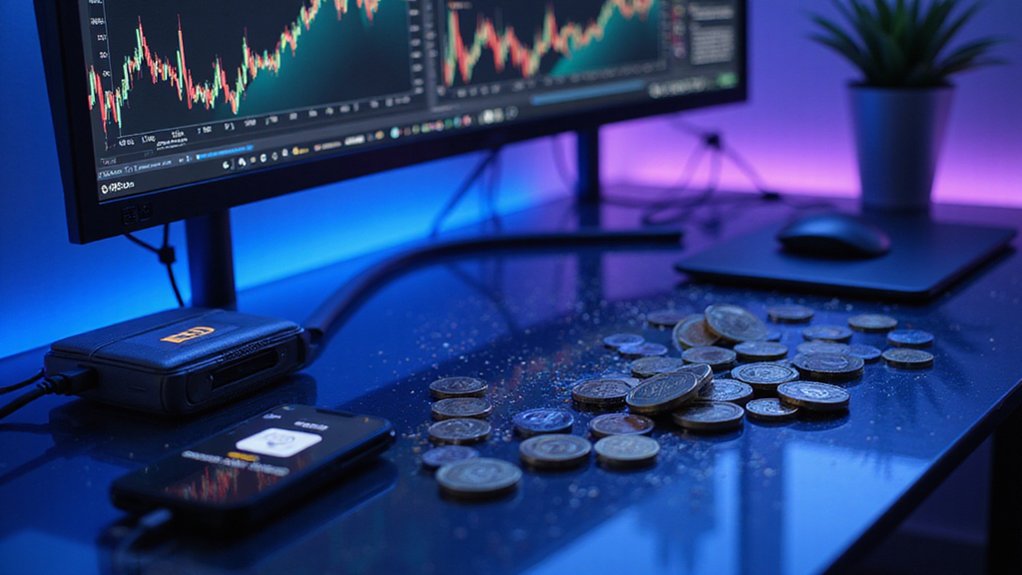To install MetaMask, navigate to metamask.io and click “Download Now.” The site detects your browser automatically—Chrome, Firefox, Brave, Edge, or Opera will all suffice. After adding the extension from your browser’s store, you’ll create a wallet, carefully record your 12-word seed phrase (treat this as if it controls your financial destiny), and select your preferred network. A quick test transaction confirms functionality. The journey into decentralized finance awaits beyond this simple gateway.

Why struggle with the complexities of cryptocurrency transactions when MetaMask offers a seamless bridge between traditional browsing and the decentralized web?
MetaMask elegantly dissolves barriers between conventional internet usage and decentralized finance, simplifying cryptocurrency engagement for everyday users.
This popular wallet extension—ubiquitous in the crypto ecosystem—provides users with an elegant portal to Ethereum-based applications while maintaining custody of their digital assets.
Installation begins with visiting to the official website (metamask.io) where users can click the prominently displayed “Download Now” button, initiating a process that detects their current browser platform.
The extension supports major browsers including Chrome, Firefox, Brave, Edge, and Opera—a extensive coverage that reflects MetaMask’s commitment to accessibility.
Once redirected to the appropriate webstore, users simply select “Add to Browser” and wait momentarily as the installation completes.
(One might wonder why other financial tools couldn’t adopt such straightforward implementation.)
Post-installation, users should verify the extension appears in their browser’s toolbar, confirming its successful integration.
Setting up the wallet requires meticulous attention, particularly during seed phrase generation—a 12-word combination that functions as the ultimate recovery mechanism for one’s digital assets.
This phrase must be recorded and stored with extraordinary care, as its compromise represents an irreversible security breach.
The setup wizard guides users through network selection, allowing connection to Ethereum’s mainnet or various testnets depending on one’s objectives.
Beyond Ethereum, users can configure MetaMask to interact with Polygon sidechain for faster and more cost-effective transactions while maintaining Ethereum compatibility.
Should installation complications arise, users might encounter browser compatibility issues or extension errors requiring troubleshooting.
Clearing cache or attempting reinstallation often resolves these impediments.
After successful setup, prudent users conduct post-installation verification: checking wallet balances, confirming network connectivity, and executing a nominal test transaction to verify functionality.
For Chrome users specifically, it’s recommended to pin to toolbar after installation for convenient access to your wallet.
The extension provides a secure key vault for cryptocurrency management while connecting users to the growing web3 ecosystem.
The MetaMask experience transcends mere wallet functionality, serving as an educational portal to blockchain technology while facilitating participation in the decentralized economy.
Users benefit from additional resources including official guides and video tutorials—supplementary materials that elucidate the nuances of this increasingly essential financial tool in our rapidly evolving digital landscape.
Frequently Asked Questions
What Are the Gas Fees on Metamask and How Can I Reduce Them?
Gas fees in MetaMask are transaction costs paid to process operations on Ethereum’s blockchain, calculated as (base fee + priority fee) × gas limit.
Users can reduce these inevitable tariffs through several strategies: transacting during off-peak hours when network congestion abates, employing Layer 2 solutions that offload processing demands, batching multiple transactions, and judiciously setting lower gas prices (accepting the trade-off of potentially prolonged confirmation times).
MetaMask’s advanced gas controls allow for manual adjustments to optimize expenditure.
How Do I Recover My Metamask Wallet if I Forget My Password?
If a MetaMask password is forgotten, recovery hinges on that all-important Secret Recovery Phrase (SRP)—those 12 magical words that access digital fortunes.
One simply imports the SRP into MetaMask and creates a new password.
Without this crypto-phylactery, however, options become distressingly limited¹.
The vault decryptor tool offers no salvation absent the password it requires to function.
Hence the mantra: guard thy seed phrase with one’s very life.
¹Unlike conventional financial services, cryptocurrency’s promise of self-sovereignty comes with commensurate responsibility.
Is Metamask Secure for Storing Large Amounts of Cryptocurrency?
MetaMask alone isn’t ideal for substantial cryptocurrency holdings.
While it employs local encryption and threat monitoring, its hot wallet nature inherently exposes assets to browser vulnerabilities and malware risks.
The prudent investor pairs MetaMask with hardware wallets (Ledger, Trezor, NGRAVE ZERO) for cold storage protection of significant assets.
The irreversibility of blockchain transactions magnifies the consequences of security lapses—a sobering reality that should give pause to anyone contemplating storing their crypto fortune in browser-based solutions.
Can I Connect Metamask to Hardware Wallets Like Ledger or Trezor?
Yes, MetaMask seamlessly integrates with hardware wallets like Ledger and Trezor—a prudent choice for anyone serious about crypto security.
This connection creates a fortified arrangement where transactions initiated in MetaMask require physical confirmation on the hardware device, keeping private keys safely offline.
The setup process is straightforward: connect the hardware wallet, select it within MetaMask’s interface, and follow the authentication prompts—a small investment of time for significant security dividends.
How Do I Add Custom Tokens That Don’t Appear Automatically in Metamask?
To add custom tokens in MetaMask, users need to navigate to the “Tokens” tab, select “Custom Token,” and enter the token’s contract address—that financial fingerprint so many crypto neophytes overlook.
The system typically auto-populates symbol and decimal information once a valid address is provided.
Users must verify they’re on the correct network (Ethereum, Polygon, etc.) where the token exists.
For obscure tokens, contract addresses can be sourced from Etherscan, CoinGecko, or the token’s official channels.









